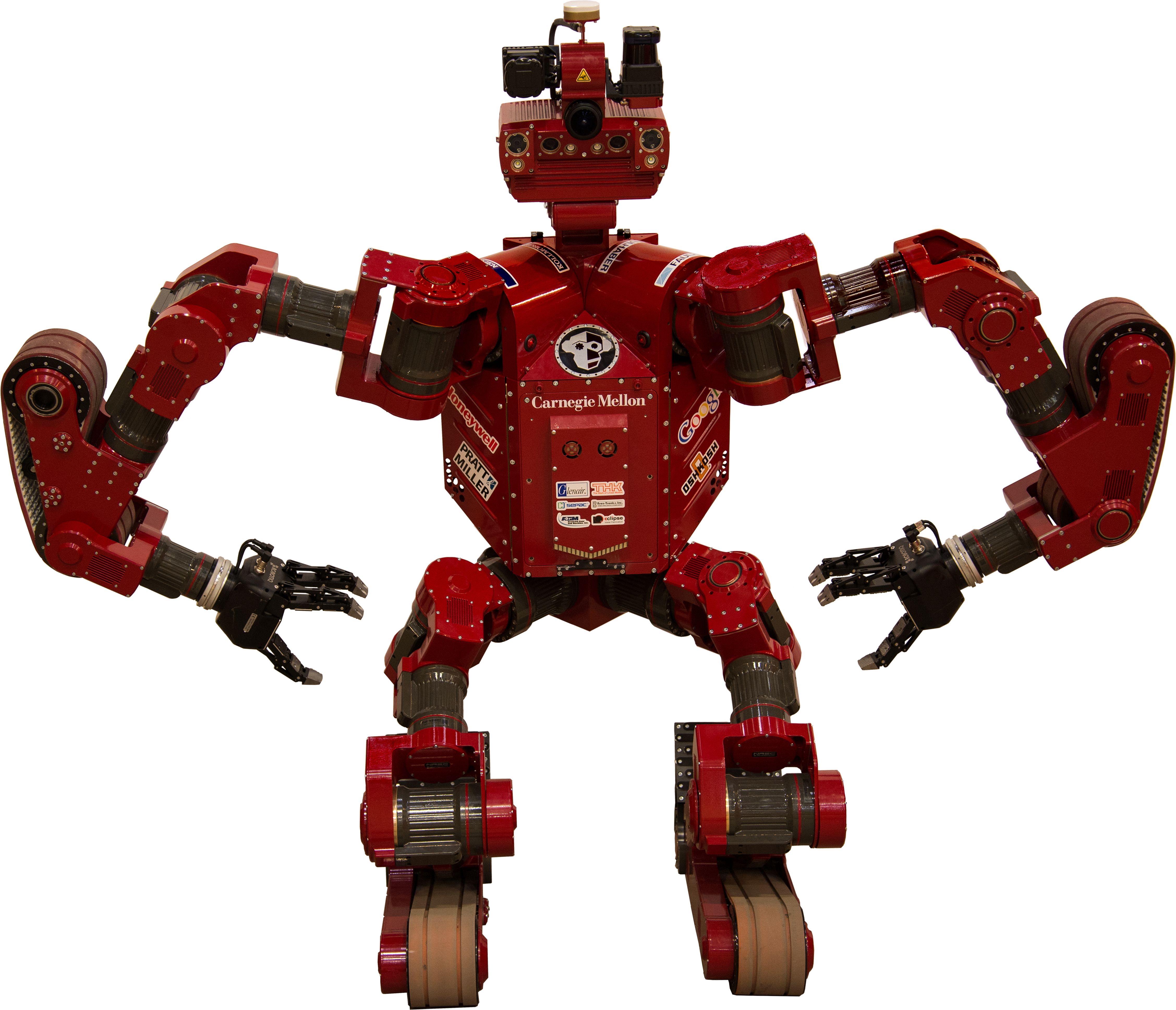DARPA Selects Carnegie Mellon’s Tartan Rescue Team For Funding To Prepare For 2014 Robotics Challenge Team’s CHIMP Robot Among Top Scorers at DARPA DRC Trials This Weekend
Byron SpiceMonday, December 23, 2013Print this page.

The Tartan Rescue Team from Carnegie Mellon University’s National Robotics Engineering Center ranked third among teams competing in the DARPA Robotics Challenge Trials this weekend in Homestead, Fla., and was selected by the agency as one of eight teams eligible for DARPA funding to prepare for next December’s Finals.
The team’s four-limbed CMU Highly Intelligent Mobile Platform, or CHIMP, robot scored 18 out of a possible 32 points during the two-day Trials. It demonstrated its ability to perform such tasks as removing debris, cutting a hole through a wall and closing a series of valves.
The Defense Advanced Research Projects Agency is sponsoring the DARPA Robotics Challenge (DRC) to spur development of robotic technologies that could be used to respond to natural or man-made disasters in environments engineered for humans, such as the Fukushima nuclear power plant crisis of 2011.
Sixteen teams competed at the Trials. DARPA on Saturday announced it would enter into funding negotiations with Tartan Rescue and seven other teams, who tallied the highest scores during the Trials. Gill Pratt, DARPA’s program manager for the DRC, said the agency has $8 million budgeted for the teams and intends to spread the money evenly between them.
Among the top scorers at the Trials was a team based at Worcester Polytechnic Institute, which includes a CMU roboticist among its leaders as well as 10 current and recent CMU graduate students and postdoctoral researchers.
Teams will compete next December in the DRC Finals, where they will need to complete a number of tasks to respond to a disaster scenario. Based on the performance of the robots at the Trials, “I think we can make the Finals a little more difficult than I had thought,” Pratt said. The winner of that contest will receive $2 million.
“I’m extremely proud that our team designed and assembled a robot as capable as CHIMP in little more than a year,” said Tony Stentz, director of the CMU Robotics Institute’s National Robotics Engineering Center (NREC) and leader of Tartan Rescue. “We wouldn’t be here without the technical excellence, dedication and just plain stamina of our team members.”
Tartan Rescue’s CHIMP had perfect score in three tasks – cutting a hole in a wall, removing wood debris and closing a series of valves. It scored points in all of the tasks it attempted, but excelled at manipulation tasks.
CHIMP is a human-size robot that, when standing, is 5-foot-2-inches tall and weighs about 400 pounds. It is not a dynamically balanced walking robot, but is a statically stable robot designed to move on tank-like treads affixed to each of its four limbs. When it needs to operate power tools, turn valves, or otherwise use its arms, CHIMP can stand and roll on its leg treads.
The robot’s long front arms — its wingspan is almost 10 feet — give it an ape-like appearance.
The Tartan Rescue Team is 50 members strong, drawing from the NREC technical staff as well as faculty, staff and students from CMU’s Robotics Institute. A core group of about 10 people have worked full-time on the project.
As a DRC Track A team, Tartan Rescue received $3 million from DARPA to help develop CHIMP. Also key to the robot’s development are the team’s sponsors: Kollmorgen, Faulhaber, Google, Honeywell, Pratt & Miller, Robotiq, JLG, Oshkosh, THK, Harmonic Drive, Elmo Motion Control, Eclipse Metal Fabrication, Sepac, AGM, Glenair and Bren-Tronics.
NREC is part of Carnegie Mellon’s acclaimed Robotics Institute. It performs advanced applied research and develops prototypes for a variety of corporate and government sponsors.
More information on CHIMP and the team, including images and video, is available online at http://www.rec.ri.cmu.edu/projects/tartanrescue/
NREC and the Robotics Institute are part of CMU’s School of Computer Science. Follow the school on Twitter @SCSatCMU and follow the Tartan Rescue Team @TartanRescue. Also look for the team on Google+, Facebook, Instagram and YouTube.
- MEDIA: DARPA has b-roll of the CMU Tartan Rescue team for download.

Byron Spice | 412-268-9068 | bspice@cs.cmu.edu
